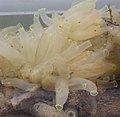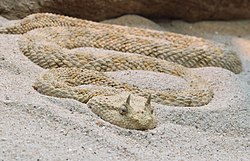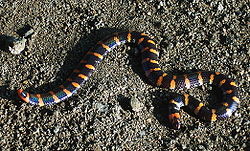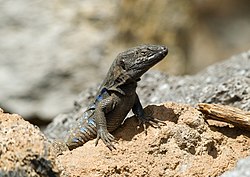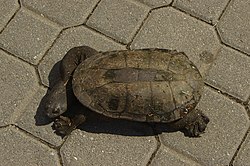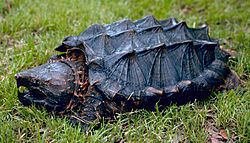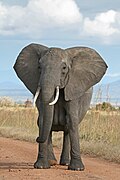Top Qs
Timeline
Chat
Perspective
List of animals by number of neurons
From Wikipedia, the free encyclopedia
Remove ads
The following are two lists of animals ordered by the size of their nervous system. The first list shows number of neurons in their entire nervous system. The second list shows the number of neurons in the structure that has been found to be representative of animal intelligence.[1] The human brain contains 86 billion neurons, with 16 billion neurons in the cerebral cortex.[2][1]
Brief comparisons of number of whole brain neurons (top) and cerebral cortex neurons (bottom) among six mammals.
Neuron counts constitute an important source of insight on the topic of neuroscience and intelligence: the question of how the evolution of a set of components and parameters (~1011 neurons, ~1014 synapses) of a complex system leads to the phenomenon of intelligence.[3]
Remove ads
Overview
Neurons are the cells that transmit information in an animal's nervous system so that it can sense stimuli from its environment and behave accordingly. Not all animals have neurons; Trichoplax and sponges lack nerve cells altogether.
Neurons may be packed to form structures such as the brain of vertebrates or the neural ganglions of insects.
The number of neurons and their relative abundance in different parts of the brain is a determinant of neural function and, consequently, of behavior.
Remove ads
Whole nervous system
Summarize
Perspective
This is a dynamic list and may never be able to satisfy particular standards for completeness. You can help by adding missing items with reliable sources.
All numbers for neurons (except Caenorhabditis and Ciona), and all numbers for synapses (except Ciona) are estimations.
More information Name, Neurons in the brain & whole nervous system ...
Close
Remove ads
Forebrain (cerebrum or pallium) only
Summarize
Perspective
Proxies for animal intelligence have varied over the centuries. One early suggestion was brain size (or weight, which provides the same ordering.) A second proposal was brain-to-body-mass ratio, and a third was encephalization quotient, sometimes referred to as EQ. The current best predictor is number of neurons in the forebrain, based on Herculano-Houzel's improved neuron counts.[1] This accounts for variation in the number of neurons in the rest of the brain, for which no link to intelligence has been established. Elephants, for example, have an exceptionally large cerebellum, while birds make do with a much smaller one.
Differing methods have been used to count neurons, and these may differ in degree of reliability. The primary methods are the optical fractionator, an application of stereology and the isotropic fractionator, a recent methodological innovation. Most numbers in the list are the result of studies using the newer isotropic fractionator.[1][41][30][45][46][48][49][50][51][57][58][59][61][62][64][66] A variation of the optical fractionator was responsible for the previous total human brain neuron count of 100,000,000,000 neurons, which has been revised down to 86,000,000,000 by the use of the isotropic fractionator. This is in part why it may be considered to be less reliable. Finally, some numbers are the result of estimations based on correlations observed between number of cortical neurons and brain mass within closely related taxa.
The following table gives information on the number of neurons estimated to be in the sensory-associative structure: the cerebral cortex (aka pallium) for mammals, the dorsal ventricular ridge ("DVR" or "hypopallium") of the pallium for birds, and the corpora pedunculata ("mushroom bodies") for insects.
More information Common name, Average number of sensory-associative structure neurons ...
| Common name | Average number of sensory-associative structure neurons[a] | Intraspecific variation[b] | Method[c] | Sensory-associative structure | Binomial nomenclature | Image | Source |
|---|---|---|---|---|---|---|---|
| Common fruit fly | 2,500* | Optical fractionator | Corpora pedunculata | Drosophila melanogaster |  |
[67] | |
| House cricket | 50,000* | Optical fractionator | Corpora pedunculata | Acheta domesticus |  |
[67] | |
| Honey bee | 170,000* | Optical fractionator | Corpora pedunculata | Genus: Apis |  |
[67] | |
| Common cockroach | 200,000* | Optical fractionator | Corpora pedunculata | Genus: Periplaneta |  |
[67] | |
| African sheath-tailed bat | 5,000,000 | Isotropic fractionator | Pallium (cortex) | Coleura afra | [42] | ||
| Rufous trident bat | 6,000,000 | Isotropic fractionator | Pallium (cortex) | Triaenops persicus | [42] | ||
| Naked mole-rat | 6,000,000 | ± 1,065,587[44] | Isotropic fractionator | Pallium (cortex) | Heterocephalus glaber |  |
[41] |
| Little free-tailed bat | 6,000,000 | Isotropic fractionator | Pallium (cortex) | Chaerephon pumilus |  |
[42] | |
| Common bent-wing bat | 6,000,000 | Isotropic fractionator | Pallium (cortex) | Miniopterus schreibersii | [42] | ||
| Commerson's roundleaf bat | 8,000,000 | Isotropic fractionator | Pallium (cortex) | Hipposideros commersoni |  |
[42] | |
| Heart-nosed bat | 10,000,000 | Isotropic fractionator | Pallium (cortex) | Cardioderma cor |  |
[42] | |
| Ansell's mole-rat | 10,000,000 | Isotropic fractionator | Pallium (cortex) | Fukomys anselli |  |
[47] | |
| Smoky shrew | 10,000,000 | ± 352,000[44] | Isotropic fractionator | Pallium (cortex) | Sorex fumeus |  |
[44] |
| Short-palated fruit bat | 10,000,000 | Isotropic fractionator | Pallium (cortex) | Casinycteris argynnis | [42] | ||
| Mashona mole-rat | 12,000,000 | Isotropic fractionator | Pallium (cortex) | Fukomys darlingi | [47] | ||
| Woermann's bat | 12,000,000 | Isotropic fractionator | Pallium (cortex) | Megaloglossus woermanni | [42] | ||
| Northern short-tailed shrew | 12,000,000 | ± 1,569,000[44] | Isotropic fractionator | Pallium (cortex) | Blarina brevicauda |  |
[44] |
| Zenker's fruit bat | 13,000,000 | Isotropic fractionator | Pallium (cortex) | Scotonycteris zenkeri | [42] | ||
| House mouse | 14,000,000 | ± 2,242,257[44] | Isotropic fractionator | Pallium (cortex) | Mus musculus |  |
[44] |
| Hairy-tailed mole | 16,000,000 | ± 2,611,000[44] | Isotropic fractionator | Pallium (cortex) | Parascalops breweri |  |
[44] |
| Star-nosed mole | 17,000,000 | ± 3,105,000[44] | Isotropic fractionator | Pallium (cortex) | Condylura cristata |  |
[44] |
| Golden hamster | 17,000,000 | ± 3,619,934[44] | Isotropic fractionator | Pallium (cortex) | Mesocricetus auratus |  |
[44] |
| Diamond dove | 18,209,000 | Isotropic fractionator | Pallium (DVR) | Geopelia cuneata |  |
[35] | |
| King quail | 20,523,000 | Isotropic fractionator | Pallium (DVR) | Synoicus chinensis |  |
[35] | |
| Damaraland mole-rat | 21,000,000 | Isotropic fractionator | Pallium (cortex) | Fukomys damarensis |  |
[47] | |
| Hottentot golden mole | 22,000,000 | ± 2,154,000[44] | Isotropic fractionator | Pallium (cortex) | Amblysomus hottentotus |  |
[44] |
| Gray mouse lemur | 22,310,000 | Isotropic fractionator | Pallium (cortex) | Microcebus murinus |  |
[50] | |
| Common quail | 22,568,000 | Isotropic fractionator | Pallium (DVR) | Coturnix coturnix |  |
[35] | |
| Mechow's mole-rat | 23,000,000 | Isotropic fractionator | Pallium (cortex) | Fukomys mechowii |  |
[47] | |
| Franquet's epauletted fruit bat | 23,000,000 | Isotropic fractionator | Pallium (cortex) | Epomops franqueti | [42] | ||
| Hammer-headed bat | 24,000,000 | Isotropic fractionator | Pallium (cortex) | Hypsignathus mostrosus | [42] | ||
| Hedgehog | 24,000,000^ | Estimated | Pallium (cortex) | Subfamily Erinaceinae, various species |  |
[68] | |
| Silvery mole-rat | 25,000,000 | Isotropic fractionator | Pallium (cortex) | Heliophobius argenteocinereus |  |
[47] | |
| Wahlberg's epauletted fruit bat | 26,000,000 | Isotropic fractionator | Pallium (cortex) | Epomophorus wahlbergi |  |
[42] | |
| Cape mole-rat | 26,000,000 | Isotropic fractionator | Pallium (cortex) | Georychus capensis |  |
[47] | |
| Guyenne spiny rat | 26,000,000 | ± 2,155,723[44] | Isotropic fractionator | Pallium (cortex) | Proechimys cayennensis | [44] | |
| Eastern rock elephant shrew | 26,000,000 | ± 4,020,000[44] | Isotropic fractionator | Pallium (cortex) | Elephantulus myurus |  |
[44] |
| Eastern mole | 27,000,000 | ± 5,113,000[44] | Isotropic fractionator | Pallium (cortex) | Scalopus aquaticus |  |
[44] |
| Opossum | 27,000,000^ | Estimated | Pallium (cortex) | Didelphis virginiana |  |
[68] | |
| Egyptian fruit bat | 29,000,000 | Isotropic fractionator | Pallium (cortex) | Rousettus aegyptiacus |  |
[42] | |
| Brown Rat | 31,000,000 | + 3,034,654[44] | Isotropic fractionator | Pallium (cortex) | Rattus norvegicus |  |
[44] |
| Four-toed elephant shrew | 34,000,000 | ± 5,840,000[44] | Isotropic fractionator | Pallium (cortex) | Petrodromus tetradactylus |  |
[44] |
| Grey partridge | 36,882,000 | Isotropic fractionator | Pallium (DVR) | Perdix perdix |  |
[35] | |
| Ferret | 38,950,000 | Isotropic fractionator | Pallium (cortex) | Mustela putorius furo | [52] | ||
| Northern bobwhite | 39,112,000 | Isotropic fractionator | Pallium (DVR) | Colinus virginianus |  |
[35] | |
| African collared dove | 39,997,000 | Isotropic fractionator | Pallium (DVR) | Streptopelia roseogrisea |  |
[35] | |
| Cape dune mole-rat | 43,000,000 | Isotropic fractionator | Pallium (cortex) | Bathyergus suillus |  |
[47] | |
| Guinea pig | 43,510,000 | ± 3,169,924[44] | Isotropic fractionator | Pallium (cortex) | Cavia porcellus |  |
[41] |
| Quebracho crested tinamou | 48,292,000 | Isotropic fractionator | Pallium (DVR) | Eudromia formosa |  |
[35] | |
| Common wood pigeon | 51,325,000 | Isotropic fractionator | Pallium (DVR) | Columba palumbus |  |
[35] | |
| Elegant crested tinamou | 51,384,000 | Isotropic fractionator | Pallium (DVR) | Eudromia elegans |  |
[35] | |
| Eurasian blackcap | 52,000,000 | Isotropic fractionator | Pallium (DVR) | Sylvia atricapilla |  |
[48] | |
| Prairie dog | 53,770,000 | ± 6,044,322[44] | Isotropic fractionator | Pallium (cortex) | Genus:Cynomys |  |
[41] |
| Zebra finch | 55,000,000 | Isotropic fractionator | Pallium (DVR) | Taeniopygia guttata |  |
[48] | |
| Chilean tinamou | 59,130,000 | Isotropic fractionator | Pallium (DVR) | Nothoprocta perdicaria |  |
[35] | |
| Common treeshrew | 60,000,000 | ± 26,510,000[44] | Isotropic fractionator | Pallium (cortex) | Tupaia glis |  |
[44] |
| Red junglefowl | 61,000,000 | Isotropic fractionator | Pallium (DVR) | Gallus gallus |  |
[48] | |
| Goldcrest | 64,000,000 | Isotropic fractionator | Pallium (DVR) | Regulus regulus |  |
[48] | |
| European rabbit | 71,450,000 | Isotropic fractionator | Pallium (cortex) | Oryctolagus cuniculus |  |
[41] | |
| Rock dove | 72,000,000 | Isotropic fractionator | Pallium (DVR) | Columba livia |  |
[48] | |
| Eastern gray squirrel | 77,330,000 | ± 2,634,444[44] | Isotropic fractionator | Pallium (cortex) | Sciurius carolinensis |  |
[41] |
| Reeves's pheasant | 80,688,000 | Isotropic fractionator | Pallium (DVR) | Syrmaticus reevesii |  |
[35] | |
| Great tit | 83,000,000 | Isotropic fractionator | Pallium (DVR) | Parus major |  |
[48] | |
| Eurasian sparrowhawk | 87,832,000 | Isotropic fractionator | Pallium (DVR) | Accipiter nisus |  |
[35] | |
| Western tree hyrax | 99,000,000 | Isotropic fractionator | Pallium (cortex) | Dendrohyrax dorsalis |  |
[44] | |
| Green-rumped parrotlet | 103,000,000 | Isotropic fractionator | Pallium (DVR) | Forpus passerinus |  |
[48] | |
| Wild turkey | 105,654,000 | Isotropic fractionator | Pallium (DVR) | Meleagris gallopavo |  |
[35] | |
| Mallard | 112,255,000 | Isotropic fractionator | Pallium (DVR) | Anas platyrhynchos |  |
[35] | |
| Black-rumped agouti | 113,000,000 | ± 2,576,768[44] | Isotropic fractionator | Pallium (cortex) | Dasyprocta prymnolopha |  |
[1] |
| Banded mongoose | 115,770,000 | Isotropic fractionator | Pallium (cortex) | Mungos mungo |  |
[52] | |
| Victoria crowned pigeon | 118,445,000 | Isotropic fractionator | Pallium (DVR) | Goura victoria |  |
[35] | |
| Yellow-knobbed curassow | 124,624,000 | Isotropic fractionator | Pallium (DVR) | Crax daubentoni |  |
[35] | |
| Indian peafowl | 129,621,000 | Isotropic fractionator | Pallium (DVR) | Pavo cristatus |  |
[35] | |
| Marbled duck | 130,142,000 | Isotropic fractionator | Pallium (DVR) | Marmaronetta angustirostris |  |
[35] | |
| Pygmy falcon | 131,898,000 | Isotropic fractionator | Pallium (DVR) | Polihierax semitorquatus |  |
[35] | |
| Common blackbird | 136,000,000 | Isotropic fractionator | Pallium (DVR) | Turdus merula |  |
[48] | |
| Wood duck | 138,206,000 | Isotropic fractionator | Pallium (DVR) | Aix sponsa |  |
[35] | |
| Red-breasted goose | 148,617,000 | Isotropic fractionator | Pallium (DVR) | Branta ruficollis |  |
[35] | |
| Budgerigar | 149,000,000 | Isotropic fractionator | Pallium (DVR) | Melopsittacus undulatus |  |
[48] | |
| Eurasian teal | 167,287,000 | Isotropic fractionator | Pallium (DVR) | Anas crecca |  |
[35] | |
| Rock hyrax | 198,000,000 | ± 29,082,000[44] | Isotropic fractionator | Pallium (cortex) | Procavia capensis |  |
[44] |
| Northern greater galago | 226,000,000 | ± 87,570,000[44] | Isotropic fractionator | Pallium (cortex) | Otolemur garnettii |  |
[44] |
| Common starling | 226,000,000 | Isotropic fractionator | Pallium (DVR) | Sturnus vulgaris |  |
[48] | |
| Common kestrel | 237,903,000 | Isotropic fractionator | Pallium (DVR) | Falco tinnunculus | 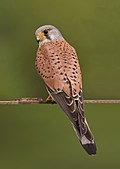 |
[35] | |
| Raccoon dog | 240,180,000 | Isotropic fractionator | Pallium (cortex) | Nyctereutes procyonoides |  |
[56] | |
| Common marmoset | 245,000,000 | ± 81,180,000[44] | Isotropic fractionator | Pallium (cortex) | Callithrix jacchus |  |
[44] |
| House cat | 249,830,000 | Isotropic fractionator | Pallium (cortex) | Felis catus |  |
[52] | |
| Brown bear | 250,970,000 | Isotropic fractionator | Pallium (cortex) | Ursus arctos |  |
[52] | |
| Cockatiel | 258,000,000 | Isotropic fractionator | Pallium (DVR) | Nymphicus hollandicus |  |
[48] | |
| Greylag goose | 258,650,000 | Isotropic fractionator | Pallium (DVR) | Anser anser |  |
[35] | |
| Capybara | 306,500,000 | ± 62,726,120[44] | Isotropic fractionator | Pallium (cortex) | Hydrochoerus hydrochaeris |  |
[41] |
| Tarsius | 310,000,000 | Estimated | Pallium (cortex) | Genus: Tarsius, unknown species |  |
[69] | |
| Mute swan | 323,661,000 | Isotropic fractionator | Pallium (DVR) | Cygnus olor |  |
[35] | |
| Greater rhea | 330,342,000 | Isotropic fractionator | Pallium (DVR) | Rhea americana |  |
[35] | |
| Eastern rosella | 333,000,000 | Isotropic fractionator | Pallium (DVR) | Platycercus eximius |  |
[48] | |
| Common buzzard | 351,700,000 | Isotropic fractionator | Pallium (DVR) | Buteo buteo |  |
[35] | |
| Red fox | 355,010,000 | Isotropic fractionator | Pallium (cortex) | Vulpes vulpes |  |
[56] | |
| Goeldi's marmoset | 357,130,000 | Isotropic fractionator | Pallium (cortex) | Callimico goeldii |  |
[50] | |
| Eurasian pygmy owl | 364,000,000 | Isotropic fractionator | Pallium (DVR) | Glaucidium passerinum |  |
[35] | |
| Western grey kangaroo | 370,170,000 | Isotropic fractionator | Pallium (cortex) | Macropus fuliginosus |  |
[70] | |
| Golden jackal | 393,620,000 | Isotropic fractionator | Pallium (cortex) | Canis aureus |  |
[56] | |
| Monk parakeet | 396,000,000 | Isotropic fractionator | Pallium (DVR) | Myiopsitta monachus |  |
[48] | |
| Springbok | 396,900,000 | Isotropic fractionator | Pallium (cortex) | Antidorcas marsupialis | 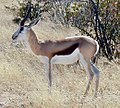 |
[57] | |
| Black vulture | 398,899,000 | Isotropic fractionator | Pallium (DVR) | Coragyps atratus |  |
[35] | |
| Azure-winged magpie | 400,000,000 | Isotropic fractionator | Pallium (DVR) | Cyanopica cyanus |  |
[48] | |
| Little owl | 400,822,000 | Isotropic fractionator | Pallium (DVR) | Athene noctua |  |
[35] | |
| Common hill myna | 410,000,000 | Isotropic fractionator | Pallium (DVR) | Gracula religiosa | 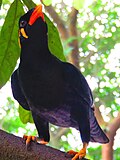 |
[48] | |
| Domesticated pig | 425,000,000* | Optical fractionator | Pallium (cortex) | Sus scrofa domesticus |  |
[71] | |
| Barn owl | 437,000,000 | Isotropic fractionator | Pallium (DVR) | Tyto alba |  |
[48] | |
| Emu | 439,000,000 | Isotropic fractionator | Pallium (DVR) | Dromaius novaehollandiae |  |
[48] | |
| West Highland White Terrier | 440,160,000 | Isotropic fractionator | Pallium (cortex) | Canis lupus familiaris |  |
[56] | |
| Three-striped night monkey | 442,000,000 | ± 111,310,000[44] | Isotropic fractionator | Pallium (cortex) | Aotus trivirgatus |  |
[1] |
| Saker falcon | 442,946,000 | Isotropic fractionator | Pallium (DVR) | Falco cherrug |  |
[35] | |
| Eurasian magpie | 443,000,000 | Isotropic fractionator | Pallium (DVR) | Pica pica |  |
[48] | |
| Raccoon | 453,000,000 | Isotropic fractionator | Pallium (cortex) | Procyon lotor |  |
[66] | |
| Chow Chow | 471,500,000 | Isotropic fractionator | Pallium (cortex) | Canis lupus familiaris |  |
[56] | |
| Common ostrich | 479,410,000 | Isotropic fractionator | Pallium (DVR) | Struthio camelus |  |
[35] | |
| Western jackdaw | 492,000,000 | Isotropic fractionator | Pallium (DVR) | Coloeus monedula |  |
[48] | |
| Striped hyena | 495,280,000 | Isotropic fractionator | Pallium (cortex) | Hyaena hyaena |  |
[52] | |
| Chihuahua | 513,330,000 | Isotropic fractionator | Pallium (cortex) | Canis lupus familiaris |  |
[56] | |
| Eurasian jay | 529,000,000 | Isotropic fractionator | Pallium (DVR) | Garrulus glandarius |  |
[48] | |
| White-tailed eagle | 542,926,000 | Isotropic fractionator | Pallium (DVR) | Haliaeetus albicilla |  |
[35] | |
| Lion | 545,240,000 | Isotropic fractionator | Pallium (cortex) | Panthera leo |  |
[52] | |
| Blesbok | 570,670,000 | Isotropic fractionator | Pallium (cortex) | Damaliscus pygargus phillipsi |  |
[57] | |
| Yorkshire Terrier | 572,140,000 | Isotropic fractionator | Pallium (cortex) | Canis lupus familiaris |  |
[56] | |
| Alexandrine parakeet | 575,000,000 | Isotropic fractionator | Pallium (DVR) | Psittacula eupatria |  |
[48] | |
| Tanimbar corella | 599,000,000 | Isotropic fractionator | Pallium (DVR) | Cacatua goffiniana |  |
[48] | |
| Golden retriever | 627,000,000 | Isotropic fractionator | Pallium (cortex) | Canis lupus familiaris |  |
[52] | |
| Long-eared owl | 673,000,000 | Isotropic fractionator | Pallium (DVR) | Asio otus |  |
[35] | |
| Transylvanian Hound | 725,760,000 | Isotropic fractionator | Pallium (cortex) | Canis lupus familiaris |  |
[56] | |
| Greater kudu | 762,570,000 | Isotropic fractionator | Pallium (cortex) | Tragelaphus strepsiceros |  |
[57] | |
| Crab-eating macaque | 800,960,000 | Isotropic fractionator | Pallium (cortex) | Macaca fascicularis |  |
[50] | |
| Rook | 820,000,000 | Isotropic fractionator | Pallium (DVR) | Corvus frugilegus |  |
[48] | |
| Beagle | 844,410,000 | Isotropic fractionator | Pallium (cortex) | Canis lupus familiaris |  |
[56] | |
| Grey parrot | 850,000,000 | Isotropic fractionator | Pallium (DVR) | Psittacus erithacus |  |
[48] | |
| Komondor | 883,380,000 | Isotropic fractionator | Pallium (cortex) | Canis lupus familiaris |  |
[56] | |
| German Shepherd | 885,460,000 | Isotropic fractionator | Pallium (cortex) | Canis lupus familiaris |  |
[56] | |
| Sulphur-crested cockatoo | 1,135,000,000 | Isotropic fractionator | Pallium (DVR) | Cacatua galerita |  |
[48] | |
| Tufted capuchin | 1,140,000,000 | Isotropic fractionator | Pallium (cortex) | Sapajus apella |  |
[44][1] | |
| Tawny owl | 1,153,000,000 | Isotropic fractionator | Pallium (DVR) | Strix aluco |  |
[35] | |
| Harp seal | 1,168,000,000^
6,100,000,000* |
Estimated
Optical fractionator |
Pallium (cortex) | Pagophilus groenlandicus |  |
[72][73] | |
| Horse | 1,200,000,000^ | Estimated | Pallium (cortex) | Equus ferus caballus |  |
[74] | |
| Raven | 1,204,000,000 | Isotropic fractionator | Pallium (DVR) | Corvus corax |  |
[48] | |
| Snowy owl | 1,270,000,000 | Isotropic fractionator | Pallium (DVR) | Bubo scandiacus |  |
[35] | |
| Kea | 1,281,000,000 | Isotropic fractionator | Pallium (DVR) | Nestor notabilis |  |
[48] | |
| Eurasian eagle-owl | 1,328,000,000 | Isotropic fractionator | Pallium (DVR) | Bubo bubo |  |
[35] | |
| Common squirrel monkey | 1,340,000,000 | ± 20,000,000[44] | Isotropic fractionator | Pallium (cortex) | Saimiri sciureus |  |
[44] |
| Bonnet macaque | 1,660,000,000 | Isotropic fractionator | Pallium (cortex) | Macaca radiata |  |
[44] | |
| Rhesus macaque | 1,710,000,000 | Isotropic fractionator | Pallium (cortex) | Macaca mulatta |  |
[44] | |
| Giraffe | 1,731,000,000 | Isotropic fractionator | Pallium (cortex) | Giraffa camelopardalis | 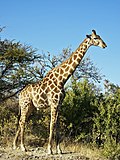 |
[57] | |
| Blue and yellow macaw | 1,900,000,000 | Isotropic fractionator | Pallium (DVR) | Ara ararauna |  |
[48] | |
| Pygmy sperm whale | 2,020,000,000* | Optical fractionator | Pallium (cortex) | Kogia breviceps |  |
[75] | |
| Leopard seal | 2,386,000,000^ | Estimated | Pallium (cortex) | Hydrurga leptonyx |  |
[72] | |
| Guenon | 2,500,000,000^ | Estimated | Pallium (cortex) | Genus: Cercopithecus, unknown species |  |
[69] | |
| Pigtail Macaque | 2,531,000,000^ | Estimated | Pallium (cortex) | Macaca nemestrina | 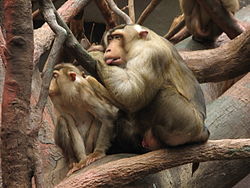 |
[72] | |
| Gelada baboon | 2,568,000,000^ | Estimated | Pallium (cortex) | Theropithecus gelada |  |
[72] | |
| Red-and-green macaw | 2,646,000,000^ | Estimated | Pallium (DVR) | Ara chloropterus |  |
[72] | |
| Harbor porpoise | 2,750,000,000* | Optical fractionator | Pallium (cortex) | Phocoena phocoena |  |
[72][73] | |
| Yellow baboon | 2,880,000,000 | Isotropic fractionator | Pallium (cortex) | Papio cynocephalus |  |
[50] | |
| Hyacinth macaw | 2,944,000,000^ | Estimated | Pallium (DVR) | Anodorhynchus hyacinthinus |  |
[72] | |
| Hamadryas baboon | 2,990,000,000^ | Estimated | Pallium (cortex) | Papio hamadryas |  |
[72] | |
| Mandrill | 3,102,000,000^ | Estimated | Pallium (cortex) | Mandrillus sphinx |  |
[72] | |
| Common minke whale | 3,134,000,000
12,800,000,000* |
Isotropic fractionator
Optical fractionator |
Pallium (cortex) | Balaenoptera acutorostrata |  |
[60][76] | |
| Walrus | 3,929,000,000^ | Estimated | Pallium (cortex) | Odobenus rosmarus | 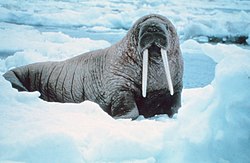 |
[72] | |
| Southern elephant seal | 3,994,000,000^ | Estimated | Pallium (cortex) | Mirounga leonina |  |
[72] | |
| Fin whale | 5,000,000,000^
15,000,000,000^ |
Estimated | Pallium (cortex) | Balaenoptera physalus |  |
[72][77] | |
| Blue whale | 5,000,000,000^ | Estimated | Pallium (cortex) | Balaenoptera musculus |  |
[72] | |
| African elephant | 5,600,000,000 | Isotropic fractionator | Pallium (cortex) | Loxodonta africana | 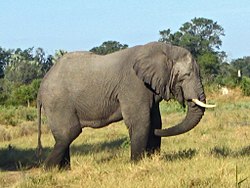 |
[64] | |
| Pygmy chimpanzee or bonobo | 6,250,000,000^ | Estimated | Pallium (cortex) | Pan paniscus |  |
[72] | |
| Short-beaked common dolphin | 6,700,000,000*
4,800,000,000^ |
Optical fractionator
Estimated |
Pallium (cortex) | Delphinus delphis |  |
[72][75][60] | |
| Asian elephant | 6,775,000,000^ | Estimated | Pallium (cortex) | Elephas maximus |  |
[72] | |
| Chimpanzee | 7,400,000,000* | Optical fractionator | Pallium (cortex) | Pan troglodytes |  |
[78] | |
| Orangutan | 7,704,000,000^ - 8,900,000,000^ | Estimated | Pallium (cortex) | Genus: Pongo |  |
[72][59] | |
| Western gorilla | 9,100,000,000^ | Estimated | Pallium (cortex) | Gorilla gorilla |  |
[72][59] | |
| Cuvier's beaked whale | 9,100,000,000* | Optical fractionator | Pallium (cortex) | Ziphius cavirostris |  |
[75] | |
| Beluga whale | 10,000,000,000^ | Estimated | Pallium (cortex) | Delphinapterus leucas |  |
[72][60] | |
| Risso's dolphin | 10,000,000,000^ | Estimated | Pallium (cortex) | Grampus griseus |  |
[72][60] | |
| Short-finned pilot whale | 11,850,000,000 | Isotropic fractionator | Pallium (cortex) | Globicephala macrorhynchus |  |
[72][60] | |
| Bottlenose dolphin | 12,700,000,000*
8,700,000,000^ |
Optical fractionator
Estimated |
Pallium (cortex) | Tursiops truncatus |  |
[72][75][60] | |
| Long-finned pilot whale | 13,966,000,000^
37,200,000,000* |
Estimated
Optical fractionator |
Pallium (cortex) | Globicephala melas |  |
[79][72][60] | |
| Human | 16,340,000,000
21,000,000,000* |
± 2,170,000,000[44] | Isotropic fractionator
Optical fractionator |
Pallium (cortex) | Homo sapiens |  |
[44][61][1][80][81] |
| Orca | 43,100,000,000*
21,000,000,000^ |
Optical fractionator
Estimated |
Pallium (cortex) | Orcinus orca |  |
[72][75][60] |
Close
Remove ads
See also
Notes
- For the estimated values, the numbers of cortical neurons estimated from brain mass for different mammalian and bird orders are based on correlation observed between number of cortical neuron and brain mass per order[44]
References
Wikiwand - on
Seamless Wikipedia browsing. On steroids.
Remove ads
Remove ads







